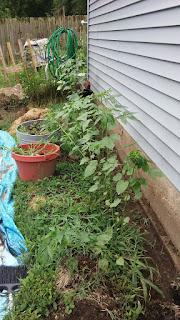This is the Tap Root of a Kenaf Plant that I pulled
out of the ground 11/21/16. The Kenaf Plant was
dying from the cold temps of St Louis the past few
days. Two days of the temperatures below 33 Deg F
at night is all it took.
These photos were also highlighted at the Hemp
Environmental Forum and the Kenaf Community.
out of the ground 11/21/16. The Kenaf Plant was
dying from the cold temps of St Louis the past few
days. Two days of the temperatures below 33 Deg F
at night is all it took.
Kenaf Plants are also called Indian Hemp by some people.
These photos were also highlighted at the Hemp
Environmental Forum and the Kenaf Community.
 |
| Tap Root System of Kenaf Plant from the Kenaf Test Plants |
Additional Kenaf Growing Notes
- The seeds were planted for this plant in midsummer 2016.
- The plants were only hand watered twice due to dry conditions and it wasn't a weren't necessity. I was just playing it on the safe side. After watering them one day it rained that night so I wasted water-aarrgh.
- This particular Kenaf Plant was over 10 feet Tall at harvest time.
- Normal Size Bic Lighter was used for scaling purposes
 |
| Kenaf Seeds from Scottys Kenaf Test Plants |
- Remarkable plant that started out as a seed about the same size as a pencil lead.























